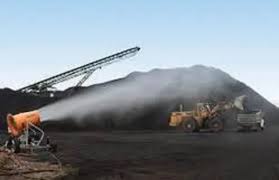Fog Cannon
the science of dust suppression using fog cannons
Dheeraj
8/8/20254 min read


Dust is more than a nuisance — in mines, quarries, demolition and bulk-handling sites it’s a health, visibility and regulatory risk. Fog cannons (aka mist cannons or misting cannons) are one of the most common large-area tools used to control fugitive dust. Below is a detailed, science-first explanation of how they work, why droplet size and dynamics matter, what physical mechanisms remove particles from air, and how to choose and operate them for best results.
What is a fog cannon?
A fog cannon is a mobile or fixed machine that atomizes water into a cloud of fine droplets and projects that mist over long distances using a high-power fan — the mist collides with airborne dust, agglomerates it and brings it to the ground. Typical commercial units vary in throw distance, oscillation and pump pressure.
Main components
High-pressure pump & feed — creates the pressure needed for fine atomization.
Atomizing nozzles / spray ring — convert pressurized water into a droplet-size distribution.
Axial/turbo fan — projects the mist plume (determines throw and momentum).
Oscillation & aiming controls — aim, tilt and sweep the plume across a target area.
Water tank / feed and optional chemical dosing — water source; additives (wetting agents) may be dosed to improve capture of very fine or hydrophobic dust.
Step-by-step: what physically happens from water → dust fall-out
Atomization — water is forced through nozzles at high pressure and breaks into many droplets with a distribution of diameters (often tens of micrometres). The nozzle type and pressure largely set the droplet size spectrum.
Projection / plume formation — the fan entrains the droplets and gives the plume momentum. That momentum determines how far and how fast the droplets travel, and how they interact with ambient wind.
Collision & capture — airborne dust particles and water droplets interact. Depending on particle and droplet sizes and relative velocities, particles are captured by one or more mechanisms (see next section). Once combined into heavier agglomerates, gravity (and the droplet’s inertia) removes them from the air — they fall to the ground.
The core physics: how droplets capture aerosol/dust particles
Multiple physical processes operate; the dominant one depends on the particle diameter (Dp), droplet diameter (Dd), relative velocities and ambient conditions:
Inertial impaction — particles with enough inertia (larger particles, higher Stokes number) cannot follow air streamlines around a droplet and directly impact its surface. Impaction dominates for coarse dust. (Stokes number concept: particle inertia vs fluid timescale — higher Stk → more likely to impact).
Interception — a particle following a streamline brushes the droplet surface because its finite size intercepts the collector. Important for intermediate sizes.
Brownian diffusion — sub-micron particles move randomly and may diffuse to and collide with droplets. This becomes significant for very small particles (< ~0.1–0.5 µm).
Phoretic effects and condensation/evaporation — vapor gradients (from evaporating or condensing droplets) and temperature gradients can drive tiny particles toward droplets thermophoresis). Electrical charges (if present) can also increase capture efficiency. Laboratory experiments show these processes can strongly affect collection efficiency, especially in the submicron range.
Bottom line: no single mechanism captures all sizes — fog cannons rely on a combination of impaction, interception and diffusion (plus phoretic/electrostatic effects) to agglomerate a broad particle size range.
Droplet size: the critical trade-off
Smaller droplets (e.g., 10–40 µm): much better at scavenging fine respirable dust by diffusion and interception because they present more surface area per unit water and can “match” the sizes of small particles. However, they evaporate faster and are more easily carried away by wind, reducing effective range. Experimental and modeling studies show collection efficiency rises as droplet diameter decreases, all else equal.
Larger droplets (e.g., 80–150 µm): hold momentum better (travel further for a given fan energy) and are less prone to evaporation, but they are less efficient at capturing sub-micron and fine particles and can over-wet surfaces.
Practical implication: fog cannon design balances droplet size, droplet count (mass flux), and plume momentum to match the site’s particle size distribution and the distance to be covered.
Fan momentum, throw distance and wind — why they matter
Droplet travel distance and residence time in the target volume are set by the fan’s airflow and momentum. A higher-momentum plume can reach further and overcome light crosswind; but in high winds the plume disperses and capture efficiency falls. Good operation therefore combines the right nozzle/pressure (droplet size) with sufficient fan thrust and strategic positioning (upwind of the dust source) to maximize encounters between droplets and dust.
Typical performance & measured efficiencies
Manufacturer claims commonly cite suppression of visible (larger) dust to 80–95% in targeted uses (point sources, stockpiles), but these numbers depend strongly on particle size mixes, wind, and setup. Treat such claims as conditional — real performance should be validated on-site.
Laboratory and field studies measure collection efficiencies across size ranges and confirm the trends above: smaller droplet diameters and higher droplet number densities raise capture efficiency, while wind and evaporation reduce it. Experimental chamber studies have quantified CE (collection efficiency) vs particle and droplet size and have refined models used to predict real-world performance.
Environmental, safety & maintenance notes
Water quality & filters: hard or dirty water will clog nozzles; filtration and routine nozzle checks are essential.
Runoff & over-wetting: fog cannons minimize runoff versus sprinklers, but poor setup can still create muddy conditions — monitor drainage.
Corrosion & pumps: regular pump servicing, winterization and nozzle replacement keep performance steady.
Chemical additive safety: ensure additives meet local environmental and health rules.
Conclusion
Fog cannons capture dust by agglomerating particles with sprayed droplets and relying on gravity and inertia to remove the mass from air.
Droplet size, droplet flux and plume momentum are the levers you control; each has trade-offs.
Real performance is site-specific: run tests, monitor dust, and combine fog cannons with other suppression strategies.
Solutions
Innovative engineering for efficient industrial operations.
Get in touch
Requirement
Mail : enquiry@ecomine.in
Mob : +919035761701
© 2025. All rights reserved.
